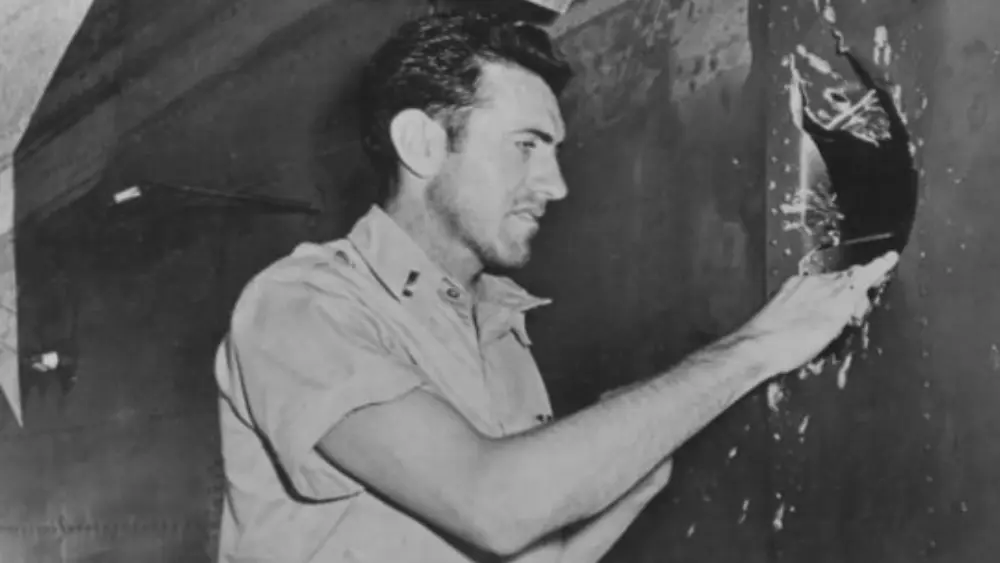Louis Zamperini, a World War II Veteran and Olympic distance runner, participated in the 1936 Berlin Olympics. He was poised to compete again in the 1940 Tokyo Games, which were canceled due to the outbreak of World War II. Serving as a bombardier in the Army Air Corps, Zamperini was aboard a plane that crashed, leading to his capture by Japanese forces. Enduring 47 days adrift at sea, he eventually became a prisoner of war and endured two years of torture. Upon his release, Zamperini emerged as an inspirational figure, and his remarkable life story became the foundation of the acclaimed 2014 biography “Unbroken: A World War II Story of Survival, Resilience, and Redemption.”
Louis Zamperini: The Journey to Olympic Glory
Louis Zamperini was an amazing person. His early life showed how strong and determined he was. Louis Silvie Zamperini was born on January 26, 1917, in Olean, New York. He would later become an American legend.
From a tender age, Louis exhibited a restive and adventurous spirit that set him apart from his peers. He grew up in Torrance, California. World War I and the Roaring Twenties influenced his childhood. It was also affected by the Great Depression. Louis found comfort and inspiration in sports, especially running. Despite his Italian immigrant family facing challenges, sports provided solace.
Louis Zamperini felt inspired and motivated as he stepped onto the track. He was ready to pursue his dreams. His commitment and strong will impressed his track coach in high school, who recognized his potential for success. Coach Seager helped Louis become an incredible athlete, breaking records and impressing everyone.
However, as the world plunged into the throes of World War II, Louis’ life would take a dramatic turn. He joined the U.S. Army Air Corps as a bombardier, ready to serve during uncertain times. He didn’t know that he would face unimaginable adversity, which would test his courage and fortitude.
The Olympics and World Records
Louis Zamperini’s meteoric rise in the world of athletics culminated in a spectacular display of skill and determination at the 1936 Berlin Olympics. Representing the United States in the 5,000-meter race, Louis captivated the world with his awe-inspiring performance. Despite his young age and limited international experience, Zamperini displayed an indomitable spirit, pushing himself to the limits in a race that featured some of the finest runners of his time. Though he didn’t secure a medal, his sheer tenacity earned him widespread admiration, with Adolf Hitler himself requesting a personal meeting with the young American athlete. Louis Zamperini made a lasting impression on the Olympic stage, hinting at the incredible accomplishments he would go on to achieve in the years that followed.
Following his Olympic debut, Zamperini continued to shine as a record-breaking athlete. At the 1938 NCAA Track and Field Championships, he set a new collegiate record in the mile run, further solidifying his reputation as one of America’s brightest track stars. But it was in the world of long-distance running where Louis truly made history. In 1940, he broke the national record for the mile with an astonishing time of 4 minutes and 8.3 seconds. His achievements in track and field garnered widespread acclaim and cemented his status as one of the most promising athletes of his generation.
Louis Zamperini: Enlistment and War Experience
Louis Zamperini’s path from record-breaking athlete to war hero began when he enlisted in the United States Army Air Corps in September 1941, shortly before the attack on Pearl Harbor. Commissioned as a Second Lieutenant, he served as a bombardier aboard a B-24 Liberator during World War II. Zamperini’s unit was deployed to the Pacific theater, where they faced the harrowing realities of aerial combat against the Japanese forces.
In April 1943, while on a search and rescue mission, Zamperini’s plane crashed into the vast expanse of the Pacific Ocean due to mechanical failures. Stranded at sea with two fellow crew members, he faced unimaginable hardships, including treacherous storms, scorching sun, and the constant threat of starvation and shark attacks. Despite the dire circumstances, Louis demonstrated remarkable resilience, drawing upon the mental and physical fortitude honed during his athletic career. Enduring 47 days adrift on a life raft, he displayed leadership and resourcefulness, keeping his comrades’ spirits alive and rationing their meager supplies to prolong their survival.
The trio’s ordeal was far from over, as they were eventually captured by Japanese forces after reaching the Marshall Islands. Imprisoned in brutal POW camps, Louis endured unspeakable torture and deplorable conditions at the hands of his captors. The Japanese, in particular a sadistic prison guard named Mutsuhiro Watanabe, subjected Zamperini to severe beatings and psychological torment. Despite the relentless suffering, Zamperini remained resilient, refusing to break under the weight of adversity. His resilience inspired fellow prisoners, symbolizing hope in the war’s darkness.

Louis Zamperini: The Journey to Redemption
Louis Zamperini’s journey was a testament to the incredible power of forgiveness and the human spirit’s capacity to overcome even the most profound traumas. After enduring years of unimaginable suffering as a prisoner of war in Japanese camps during World War II, Louis Zamperini was eventually liberated when the war ended in 1945. However, his physical liberation was only the beginning of a long and arduous path toward emotional and mental freedom.
Haunted by the nightmares of his wartime experiences and tormented by memories of the abuse he endured, Louis Zamperini initially struggled to find a sense of peace in the post-war world. He battled alcoholism and experienced deep emotional turmoil, searching for solace in all the wrong places. However, everything changed when he attended a Billy Graham Crusade in 1949. The powerful message of forgiveness and redemption resonated deeply with Louis, sparking a profound transformation in his life. Embracing Christianity and finding solace in his faith, he discovered the strength to forgive his former captors, including the cruel prison guard, Mutsuhiro Watanabe, who had tormented him.
Louis Zamperini’s path to redemption extended beyond his personal healing. He advocated forgiveness, using his story to inspire healing and letting go of hatred through compassion and reconciliation. He visited Japan, met ex-POW guards, and publicly forgave, fostering understanding and reconciliation between nations. Zamperini’s journey, tormented to the forgiving beacon, reminds us to rise above suffering and seek redemption through compassion and forgiveness. His life’s journey continues to inspire countless individuals to find healing and peace in the face of unimaginable adversity.




